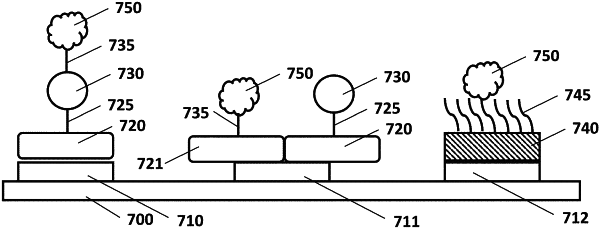| CPC G01N 21/6452 (2013.01) [B82Y 15/00 (2013.01); G01N 21/6428 (2013.01); G01N 2021/6439 (2013.01)] | 30 Claims |

|
1. A method of utilizing a single-analyte array, comprising:
a) providing the single-analyte array, wherein the single-analyte array comprises first oligonucleotides at a plurality of sites, and wherein:
each site of the plurality of sites is optically resolvable at single-analyte resolution,
each site of the plurality of sites comprises a corresponding plurality of the first oligonucleotides, each of the first oligonucleotides comprising a first nucleotide sequence,
each individual site of a first subset of the plurality of sites comprises a corresponding fiducial element of a plurality of fiducial elements, wherein the corresponding fiducial element is attached to a second oligonucleotide moiety, in a plurality of second oligonucleotide moieties, coupled to a first oligonucleotide of the corresponding plurality of first oligonucleotides for the individual site of the first subset of the plurality of sites by hybridization of the first nucleotide sequence of the first oligonucleotide with a second nucleotide sequence of the second oligonucleotide moiety, and wherein the first subset of the plurality of sites has a random spatial distribution,
the single-analyte array further comprises a plurality of single analytes, wherein each individual single analyte in the plurality of single analytes is bound to an individual site in a second subset of the plurality of sites, wherein each single analyte of the plurality of single analytes is attached to a third oligonucleotide moiety, in a plurality of third oligonucleotide moieties, coupled to a first oligonucleotide of the corresponding plurality of first oligonucleotides for the individual site of the second subset of the plurality of sites by hybridization of the first nucleotide sequence of the first oligonucleotide with a second nucleotide sequence of the third oligonucleotide moiety, and wherein each site of the second subset of the plurality of sites comprises one and only one analyte of the plurality of single analytes, and
the second nucleotide sequence of each respective second oligonucleotide moiety in the plurality of second oligonucleotide moieties and the second nucleotide sequence of each respective third oligonucleotide moiety in the plurality of third oligonucleotide moieties are the same;
b) binding an analytical reagent to a single analyte of the plurality of single analytes;
c) detecting optical signals from the first subset of the plurality of sites;
d) detecting an optical signal from the analytical reagent bound to the single analyte; and
e) based upon an address of the optical signal from the analytical reagent relative to the optical signals of the first subset of the plurality of sites, identifying a site of the second subset of the plurality of sites comprising the analytical reagent bound to the single analyte of the plurality of single analytes.
|